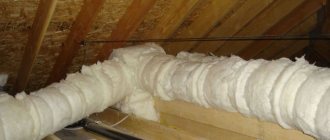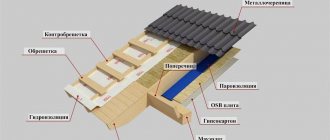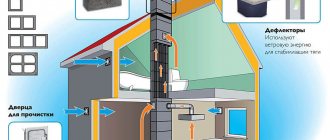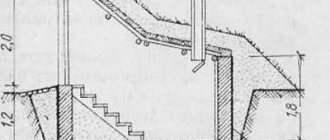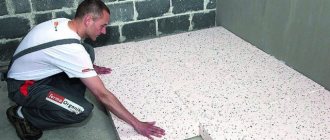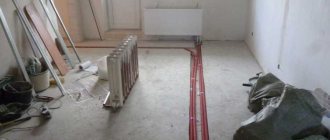With the onset of cold days, thrifty owners take care of a warm garage that will protect their car.
It is necessary to choose the right heating method, but it is equally important to organize ventilation. Both people and vehicles need it.
Ventilation in the garage in winter has its own specifics. So how to arrange everything correctly. Let's look into the details.
Features of ventilation in winter
Moisture gradually accumulates indoors. The more thoroughly the walls and ceiling are insulated, the more susceptible the garage is to this problem. Especially if the car gets caught in snow. On the body and wheels it “brings” a large amount of water, which, if ventilation is not provided, will cause metal corrosion.
The negative impact will also be reflected on the structure itself. Mold, mildew, freezing - all these are the consequences of a large amount of moisture.
There is a relationship between garage ventilation and heating. Firstly, if stove heating is chosen, more oxygen will be required for the combustion process.
Secondly, the inflow and outflow must be correlated with the power of the heater so that the room has time to warm up.
In winter, it takes longer to warm up the engine than usual.
To remove exhaust gases, you can provide a corrugated hose that will be put on the pipe and lead the exhaust directly to the street.
If in summer it is practically unimportant where and how to place the ventilation holes, then in winter you need to take into account the level of snowdrifts, which can clog the oxygen inlets and outlets.
Features of the forced ventilation system
The forced ventilation system is provided by two fans installed on the supply and exhaust openings. That is, its installation begins in the same way as if natural ventilation is used.
It is necessary to drill through holes in the walls, install pipes and protective elements in them from rodents, birds and precipitation. But, 2 fans are installed on the inside of the building. The use of such a system is effective in large garages, as well as in existing pits.
There are several options for arranging forced air exchange. In addition to overhead devices that provide good ventilation of the room, duct fans can also be used. They are installed inside the pipes.
Such systems can be equipped with an automatic on/off system. In addition, it is possible to additionally install heating elements that prevent ice from forming on frosty winter days.
One of the most expensive, but also effective devices of a forced ventilation system is climate control equipment with additional heating, air conditioning and air filtration. But its main disadvantage is its high cost. Such devices are often used for multi-level garages, as well as for rooms attached to houses.
Ventilation methods
There are three methods of ventilation:
- Natural.
- Forced.
- Combined.
All three options require the presence of openings: supply and exhaust.
In the first case, only the laws of physics will force the air to move through these holes. The correct location of the holes is important here. Warm air rises, so the outflow will be under the ceiling (or through the roof), and the inflow will be at the bottom of the wall. In addition, the quality of such ventilation is influenced by factors beyond our control: atmospheric pressure, precipitation, wind strength and direction.
Finished ventilation system in the garage
In the case of forced ventilation, additional equipment is installed - fans that will intake and exhaust air in any weather. The method is the most expensive, but also the most effective.
As for combined options, various features can be taken into account that will help save on equipment. The owner can place the fan on only one of the holes. And sometimes a decision may be made to do without one hole at all. For example, if the garage is equipped with a large door that opens completely, providing complete air exchange in a few seconds. Moreover, the owner is sure that such ventilation will occur without downtime, because he uses the car every day. Perhaps he will decide that a hood will be enough for his garage.
When deciding which option to choose, you need to weigh all the specific features, and then move on to implementing the project.
If you want to store food in a garage cellar, then garage cellar ventilation is a must. The diagram and basic installation rules are given in the article.
Making a ventilation check valve with your own hands is described in detail here.
Ventilation in the bathhouse is something that cannot be neglected, because sweat evaporation and carbon monoxide accumulate in the room, which must be removed. This topic is all about the design of the ventilation system in bath rooms - steam room and dressing room.
Types and features of ventilation
There are a number of ventilation methods: natural, combined, mechanical.
The design of the garage ventilation system should be developed during the design of the room. At this stage, the technician will understand what type of ventilation is best to use based on the size, number of floors and layout of the future location for the safety of the car.
For all types of ventilation one or two channels can be used.
Natural ventilation
This type of ventilation is the simplest to implement and does not require qualified assistance. This type of air exchange is easy to notice even from the outside. Ventilation occurs through the entrance door/gate and pipe. There are openings on the doors in the form of blinds through which air enters, as well as pipes on the roof that serve to release carbon dioxide.
However, despite the simplicity of this type of ventilation, you need to know certain rules for installing natural ventilation. You need to consider the size of the garage and the presence or absence of a basement.
Air exchange scheme
For a garage without a so-called pit, one hole is enough for fresh air to enter and one to exit. Oxygen enters through the hole in the door and passes through the entire perimeter and is discharged through the roof. However, in the absence of wind and air movement in the external environment, air exchange does not occur properly, so a special device is used - a deflector. Such a device fulfills the elementary principles of aerodynamics, increasing air draft.
If there are pits or a basement, then additional ventilation holes and deflectors are required.
It is important to remember when installing natural ventilation:
- due to the difference in external and internal temperatures, fresh air can accumulate below and air exchange will not occur;
- the minimum distance between the air inlet and outlet openings should be 3 meters;
- When installing a hole for the supply of fresh oxygen, the direction of the wind must be taken into account.
The disadvantage of such ventilation is its dependence on weather conditions, which does not provide stable ventilation of the garage.
Combined ventilation
Based on the name, this type of air exchange combines elements of natural and mechanical ventilation. Combined ventilation is more effective than natural ventilation, as it can operate regardless of weather conditions. The main difference of this type is the presence of a mechanical fan, which is installed at the outlet of the ventilation system. However, the combined type of ventilation requires constant operation of the fan.
This is what additional means of mechanical ventilation look like.
Mechanical ventilation
The most expensive and effective type of air exchange. It requires two main modules in oxygen circulation: an air supply unit, which includes a filter or fan; exhaust system, represented by two fans or one duct device. Such a system can operate in winter and summer, regardless of weather conditions.
Scheme of mechanical ventilation in a garage box
When installing such a system, you need to correctly calculate the space and ventilation power so that the room is not too small for powerful air circulation. The temperature will be below what is comfortable for the car.
Installation of natural ventilation in the garage
Natural ventilation holes should be placed as far apart from each other diagonally as possible.
A windless wall is ideal for inflow. A hole is made in the lower part, approximately at a height of 15 cm. A pipe is mounted into it, one end of which is directed upward (taking into account the height of the snow cover). A grill is mounted at the end to protect against small animals and an umbrella from precipitation.
The hood is done 15 cm from the ceiling, or in the roof. It is also equipped with a pipe with a grill and an umbrella. For the system to be as efficient as possible, the height difference between the edges of the two pipes must be 3 m or more.
Scheme of natural air circulation in the garage
For very small and not very airtight garages, it is suitable to install a special ventilation pipe with a wind catcher, which is divided inside into two channels (suction and exhaust). Each of them has its own valve.
An eternal problem in the winter is ice on the ventilation holes. It has to be knocked down manually. Some mechanical units have anti-freeze systems, but they sometimes fail. For this reason, you should not use pipes with a small diameter (at least 10 cm).
You can find out how air flows in a new ventilation system using the folk method: a bucket of hot coals is brought into the room. The smoke from them will show the direction and speed of air masses.
Rules for installing ventilation ducts
There are certain recommendations for installing ventilation pipes in the cellar:
- Ventilation pipes should be on opposite sides of the cellar. Ventilation will not work properly if the pipes are placed next to each other. It will turn out that the air that has just arrived after some time, without “walking” around the cellar, will leave through the exhaust pipe.
- The supply and exhaust pipes should have approximately equal radius. Ventilation will simply be impossible if the exhaust pipe has a smaller radius (in winter, the temperature in the cellar will begin to drop below zero, and in summer, on the contrary, it will rise to critical values for the storage facility).
- If possible, the pipes should not have any bends at all. With many bends, ventilation will be difficult. And this will negatively affect the indoor microclimate in winter.
- The supply channel should be located at a distance of 20-30 cm from the floor. This is necessary to ensure that fresh air enters the lower part of the room. It is recommended to close the upper end of the pipe with a metal mesh and a cap, which will prevent rodents and insects from entering the room in the summer, and snow in the winter.
- The lower end of the exhaust duct must be located directly under the ceiling of the cellar. Again, the laws of physics play a role here, because warm air will accumulate in large quantities just under the ceiling. The top of the pipe must be above the roof of the building, and the outlet must be protected with a cap that will prevent rain and snow from entering the pipe.
- To be able to control the exchange of air in the cellar, it is recommended to equip the pipes with dampers. It is worth noting that dampers play a big role in winter, when their use will help to maintain the conditions necessary for storing crops.
It should also be taken into account that only warm air will escape through the exhaust duct. This is why quite a lot of condensate droplets will appear in the pipe during the winter months. These drops, under the influence of negative temperatures, will soon begin to freeze, as a result of which the exhaust pipe will be completely clogged.
Insulation for pipes is polystyrene foam.
To avoid such problems, the exhaust duct must be well protected from exposure to negative temperatures. In other words, it is recommended to insulate the entire pipe using modern thermal insulation materials. It is important that the heat insulator is resistant to constant exposure to moisture; in addition, the entire structure must be systematically cleaned of frost and snow. It is ideal if the outlet part of the exhaust duct is removable.
If you have installed natural ventilation, then no problems will arise when operating the cellar in winter: air exchange (unless, of course, the channels are clogged) will be carried out in full, and no maintenance (except for cleaning the pipe) will be required. But difficulties will await you in the warm months, when the temperature outside rises higher than in the cellar. The only salvation in this case seems to be a forced ventilation device.
Combined ventilation
You can improve ineffective natural ventilation at any time by installing a small fan in the exhaust duct. The devices are relatively inexpensive. When choosing it, you need to pay attention to power and performance, shelf life and electricity consumption.
The weather varies and sometimes ventilation can become excessive. Therefore, it is good if dampers are thought out in advance, with which you can regulate the clearance of the holes, and therefore the temperature and humidity in the room.
Mechanical ventilation
In small rooms, mechanical ventilation is done in the same way as natural ventilation, but both pipes are equipped with fans.
In large multi-car garages, the ventilation system may include an air duct system, separate ventilation for the inspection pit, heat exchangers to save heat at the exit, etc.
There are ready-made units that cost several tens of thousands of rubles, but are equipped with everything necessary for suction, filtration, heating and removal of air. The operation of such a module is regulated by sensors.
Ventilation in the basement and garage cellar
Often under the garage there is a cellar for storing workpieces, which must have its own ventilation system. It doesn’t matter whether the walls are earthen, brick or concrete, the temperature in the basement will always be increased by the natural heat of the earth. Therefore, under no circumstances should the pipe be taken out of the cellar into the garage.
The basement hood is located in the ceiling and is led through the garage to the roof. The higher the pipe, the better traction it will provide. If the garage roof has a ridge, the pipe should be higher than it.
Periodically you need to check whether the draft in the hood is good and whether it is “overgrown” with frost. To do this, you can bring a piece of paper or a lit match to the hole.
The inlet can be combined with a garage. The common hole, in this case, is divided into two sleeves, one of which descends as low as possible into the subfloor. At the same time, the rule of making the entrance and exit on opposite walls of the room remains in force.
To reduce the humidity in the cellar, you can place a small container with an adsorbent in it: a cup of salt, rice, silica gel, or pour half a glass of brake fluid.
So, even the simplest ventilation in the garage is better than nothing. But to really protect yourself, your car and your building from unnecessary moisture, you should try and do ventilation according to all the rules.
In a poorly ventilated area, the car body quickly becomes unusable. Do-it-yourself ventilation in the garage - device diagram and installation rules, detailed description.
Frame houses, as a rule, are built from materials that do not allow air to pass through, so ventilation in such rooms must be arranged correctly. Read all about the features of organizing ventilation in frame buildings in this material.
What is natural ventilation and how does it work in winter?
The main driving force behind natural ventilation is the difference in pressure and temperature inside the garage and outside. The supply pipe is placed at a height of 5-10 cm from the floor, the hood is located under the ceiling and is diverted to a height of half a meter above the roof. Ventilation works best in winter, since it is during this period that temperature fluctuations and active movement of layers of air lead to the frequent occurrence of vacuum, or vice versa, pressure that moves air in the garage.
We all know that in winter the humidity level drops to almost zero when it’s cold. Wet masses are displaced by dry air and effectively dry the room, and with it the car. Natural ventilation in winter does not require the installation of additional equipment. In summer, the problem of corrosion will be eliminated due to the increased temperature.
If the ventilation system was not provided for during construction, you can easily install it yourself without the use of expensive material.
If you plan to actively use the garage, for example, for repairing, painting cars or other activities involving the release of toxic fumes, dust, moisture, it is worthwhile to provide forced ventilation. Its essence is simple - forced air circulation in the garage is ensured mechanically. The advantage of such a system will be:
- increased productivity (pumping a large volume of oxygen) – sometimes only using a pump or fan can achieve the optimal air exchange rate.
- the ability to supply ventilation to the site of contamination or where moisture needs to be quickly removed.
- It is convenient to use forced air supply during dusty work.



